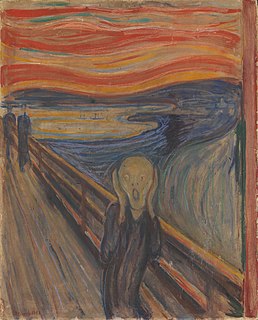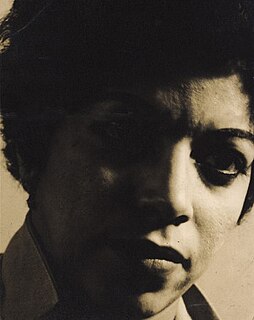Throughout history, forms of art have gone through periodic abrupt changes called artistic revolutions. Movements have come to an end to be replaced by a new movement markedly different in striking ways.

The history of painting reaches back in time to artifacts and artwork created by pre-historic artists, and spans all cultures. It represents a continuous, though periodically disrupted, tradition from Antiquity. Across cultures, continents, and millennia, the history of painting consists of an ongoing river of creativity that continues into the 21st century. Until the early 20th century it relied primarily on representational, religious and classical motifs, after which time more purely abstract and conceptual approaches gained favor.

Expressionism is a modernist movement, initially in poetry and painting, originating in Northern Europe around the beginning of the 20th century. Its typical trait is to present the world solely from a subjective perspective, distorting it radically for emotional effect in order to evoke moods or ideas. Expressionist artists have sought to express the meaning of emotional experience rather than physical reality.

Color field painting is a style of abstract painting that emerged in New York City during the 1940s and 1950s. It was inspired by European modernism and closely related to abstract expressionism, while many of its notable early proponents were among the pioneering abstract expressionists. Color field is characterized primarily by large fields of flat, solid color spread across or stained into the canvas creating areas of unbroken surface and a flat picture plane. The movement places less emphasis on gesture, brushstrokes and action in favor of an overall consistency of form and process. In color field painting "color is freed from objective context and becomes the subject in itself."
Post-expressionism is a term coined by the German art critic Franz Roh to describe a variety of movements in the post-war art world which were influenced by expressionism but defined themselves through rejecting its aesthetic. Roh first used the term in an essay in 1925, "Magic Realism: Post-Expressionism", to contrast to Gustav Friedrich Hartlaub's "New Objectivity", which more narrowly characterized these developments within German art. Though Roh saw "post-expressionism" and "magic realism" as synonymous, later critics characterized distinctions between magic realism and other artists initially identified by Hartlaub and have also pointed out other artists in Europe who had different stylistic tendencies but were working within the same trend.

The history of Western painting represents a continuous, though disrupted, tradition from antiquity until the present time. Until the mid-19th century it was primarily concerned with representational and Classical modes of production, after which time more modern, abstract and conceptual forms gained favor.

Painting is the practice of applying paint, pigment, color or other medium to a solid surface. The medium is commonly applied to the base with a brush, but other implements, such as knives, sponges, and airbrushes, can be used.

20th-century Western painting begins with the heritage of late-19th-century painters Vincent van Gogh, Paul Cézanne, Paul Gauguin, Georges Seurat, Henri de Toulouse-Lautrec, and others who were essential for the development of modern art. At the beginning of the 20th century, Henri Matisse and several other young artists including the pre-cubist Georges Braque, André Derain, Raoul Dufy and Maurice de Vlaminck, revolutionized the Paris art world with "wild", multi-colored, expressive landscapes and figure paintings that the critics called Fauvism. Matisse's second version of The Dance signified a key point in his career and in the development of modern painting. It reflected Matisse's incipient fascination with primitive art: the intense warm color of the figures against the cool blue-green background and the rhythmical succession of the dancing nudes convey the feelings of emotional liberation and hedonism.

Jaime Antonio Gumercindo González Colson was a Dominican modernist painter, writer, and playwright born in Tubagua, Puerto Plata in 1901. He is remembered as one of the most important Dominican artists of the 20th century, and as one of the leading figures of the modernist movement in 20th century Dominican art, along with Yoryi Morel, Dario Suro, and Celeste Woss y Gil.

Clara Ledesma Terrazas was an artist from the Dominican Republic.
José Victor Crowley is a self-taught Mexican painter who specializes in abstract informalism. He is classified as a member of the Generación de la Ruptura, and his influence is strongly based on his experience in Europe at the beginning of his career. His career has spanned over fifty years, becoming a member of Mexico’s Salón de la Plástica Mexicana in 2006.

Abelardo Rodríguez Urdaneta was a Dominican sculptor, photographer, painter and educator. A prolific artist, he was one of the first successful multidisciplinary artists of the modern art era in the Dominican Republic and considered to be one of the forerunners of Dominican sculpture, photography, and painting. His creative work consists of a large number of portraits, busts, statues, monuments and pictorial paintings in which he collected important moments in the country’s history that reflected the lives of social leaders, merchants, and families of the time.

Santo Domingo Church, formally known as the National Shrine of Our Lady of the Most Holy Rosary, is the largest church in Metro Manila and one of the biggest churches in Asia. It is dedicated to Mary, mother of Jesus under her title Our Lady of the Most Holy Rosary.

Woman VI is an abstract work of art painted by Willem de Kooning in 1953, which was first displayed at the Sidney Janis Gallery in Manhattan. Since the 1955 Carnegie International Exhibition, Woman VI has been on view at the Carnegie Museum of Art as part of the Postwar Abstraction collection. The Woman paintings of the early 1950's are widely considered to be de Kooning’s most important works for their significance to postwar American cultural history and social events, such as the mid-century Feminist Movements; Many of the paintings are speculated to be abstracted portraits of Marilyn Monroe. Woman VI is notable within the series for its brighter palette of green and red paint employed in larger fields of color.

Oscar Abreu is one of the top three most valued Dominican painters according to artprice.com. Oscar Abreu is also a sculptor, art collector, cultural personality and performance artist, who lives and works in Dominican Republic. Abreu is the founder of Centro Abreu and of Psycho-Expressionism, an artistic movement that emphasizes causal relationships that characterize specific psychological states.
Miguel Eduardo "Micky" Vila Luna was an architect and painter from the Dominican Republic. Miguel Vila Luna was born in Santiago de los Caballeros, Dominican Republic on July 7, 1943. His parents were Ramón Vila Piola and Ana Gregoria Luna. Vila was an individual linked to design, to aspects of decorative comfort, to pictorial work, but from the training of architecture and above all, in cultivated sensitivity that formed in the roots of his family life. After his early training in painting with Rafael Arzeno, he took up an artistic career at an art course at the University of Puerto Rico and graduated as an architect at the Catholic University of America in Washington D.C. He also attended the American University and the École Américaine des Beaux-Arts in the Palais de Fontainebleau in France. He died on April 1, 2005 in Santo Domingo, Dominican Republic.
The Asociación Arte Concreto-Invención (AACI) is an Argentinian art movement that focuses on Concrete Art. Following WWII, numerous pieces Latin American art as well as several Latin American artists used themes regarding Socialism and Reconstruction. Artists from the AACI proposed, for the first time in the history of Argentina, the necessity for an art that was different from symbolic, representational, and expressionistic art. They believed that their artwork, or "inventions" could harbor social change in their current Argentinian political climate. The founders of the AACI showed similar themes throughout their artworks, such as a desire to appear with universality, objectivity, and lack any sort of representativeness.
Jenny Altagracia Polanco de Léon was a Dominican fashion designer. Polanco, whose professional career spanned more than 37 years, was known for ready-to-wear women's clothing, jewelry, woven handbags, and other accessories that incorporated Dominican and Caribbean cultural elements into her collections. Her work was showcased throughout the Caribbean, the United States and Europe, including the Bahamas, New York City, Paris, Puerto Rico, and Miami Fashion Week.

Dominican art comprises all the visual arts and plastic arts made in Dominican Republic. Since ancient times, various groups have inhabited the island of Ayíti/Quisqueya, or Hispaniola ; the history of its art is generally compartmentalized in the same three periods throughout Dominican history: pre-Hispanic or aboriginal Amerindian, Hispanic or colonial, and the national or Dominican period.

The historical evolution of the nude in art runs parallel to the history of art in general, except for small particularities derived from the different acceptance of nudity by the various societies and cultures that have succeeded each other in the world over time. The nude is an artistic genre that consists of the representation in various artistic media of the naked human body. It is considered one of the academic classifications of works of art. Nudity in art has generally reflected the social standards for aesthetics and morality of the era in which the work was made. Many cultures tolerate nudity in art to a greater extent than nudity in real life, with different parameters for what is acceptable: for example, even in a museum where nude works are displayed, nudity of the visitor is generally not acceptable. As a genre, the nude is a complex subject to approach because of its many variants, both formal, aesthetic and iconographic, and some art historians consider it the most important subject in the history of Western art.














